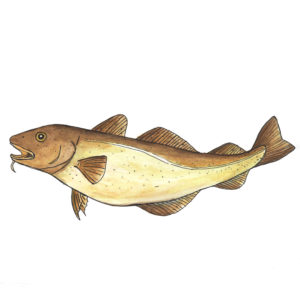You can wrap it in plastic, put it in Tupperware or do both, it still smells.
Portugal is the world leader in consuming salt-dried cod and the only country in the EU that consumes more cod than salmon.
One-third of the cod consumption occurs during the festive season. On Christmas Eve five thousand tons of cod – caught by the Norwegians in the arctic Barents sea – are being devoured.
 What began in a country with a large following Christianity as an alternative food to the Church’s fasting of meat during Lent, later became associated with Christmas. The traditional meal is called Consoada. It consists of boiled salt-dried codfish – soaked for 2 or 3 days to remove most of the salt – boiled potatoes, boiled eggs, boiled chickpeas, and boiled cabbage accompanied with a dressing of chopped raw onion, garlic, parsley, and lots of olive oil!
What began in a country with a large following Christianity as an alternative food to the Church’s fasting of meat during Lent, later became associated with Christmas. The traditional meal is called Consoada. It consists of boiled salt-dried codfish – soaked for 2 or 3 days to remove most of the salt – boiled potatoes, boiled eggs, boiled chickpeas, and boiled cabbage accompanied with a dressing of chopped raw onion, garlic, parsley, and lots of olive oil!
 Cod (bacalhau) is the nation’s favourite dish. According to the locals, there are 365 different ways to prepare it. Well-known dishes are bacalhau à lagareiro, à brás, com natas, com broa and bacalhau de cebolada. Bolinhas de bacalhau are delicious snacks. Lombos (loins) are the juiciest and most expensive parts that can be roasted, baked or grilled. Postas (steaks) are good for frying but also used in soups and stews.
Cod (bacalhau) is the nation’s favourite dish. According to the locals, there are 365 different ways to prepare it. Well-known dishes are bacalhau à lagareiro, à brás, com natas, com broa and bacalhau de cebolada. Bolinhas de bacalhau are delicious snacks. Lombos (loins) are the juiciest and most expensive parts that can be roasted, baked or grilled. Postas (steaks) are good for frying but also used in soups and stews.
 The fish isn’t native to Portuguese waters. The Vikings – who used to take air-dried cod on their sea voyages – probably introduced bacalhau in Portugal. To preserve it longer, the Basques went a step further by salting the fish before drying.
The fish isn’t native to Portuguese waters. The Vikings – who used to take air-dried cod on their sea voyages – probably introduced bacalhau in Portugal. To preserve it longer, the Basques went a step further by salting the fish before drying.
But how did cod become so popular in Portugal? Through Terra Nova (New Land)
In the European Age of Discovery and Exploration, the Portuguese claimed Newfoundland (currently part of Canada) or Terra Nova as their discovery. The island was a fish mine and named Terra dos Bacalhaus (Land of Codfish) on old Portuguese maps. Except that the protein-rich salted cod served to feed sailors on pioneering ships, the fish became an integral part of the national cuisine after the Portuguese commercialized the fisheries in the 16th century.
 Traditional fishing far away from home was easier said than done. Each fisherman was assigned a dory – a small flat-bottomed fishing boat – which was lowered from the mothership into the ice-cold waters once they reached the banks of Newfoundland. The fisherman then ventured all alone into the foggy sea and was left to his own till his boat was filled the day’s catch. The documentary The Lonely Dorymen from 1967 clearly shows the harsh conditions the men had to endure
Traditional fishing far away from home was easier said than done. Each fisherman was assigned a dory – a small flat-bottomed fishing boat – which was lowered from the mothership into the ice-cold waters once they reached the banks of Newfoundland. The fisherman then ventured all alone into the foggy sea and was left to his own till his boat was filled the day’s catch. The documentary The Lonely Dorymen from 1967 clearly shows the harsh conditions the men had to endure
Aproveite o seu dia Enjoy your day (pic Observador/Público)
